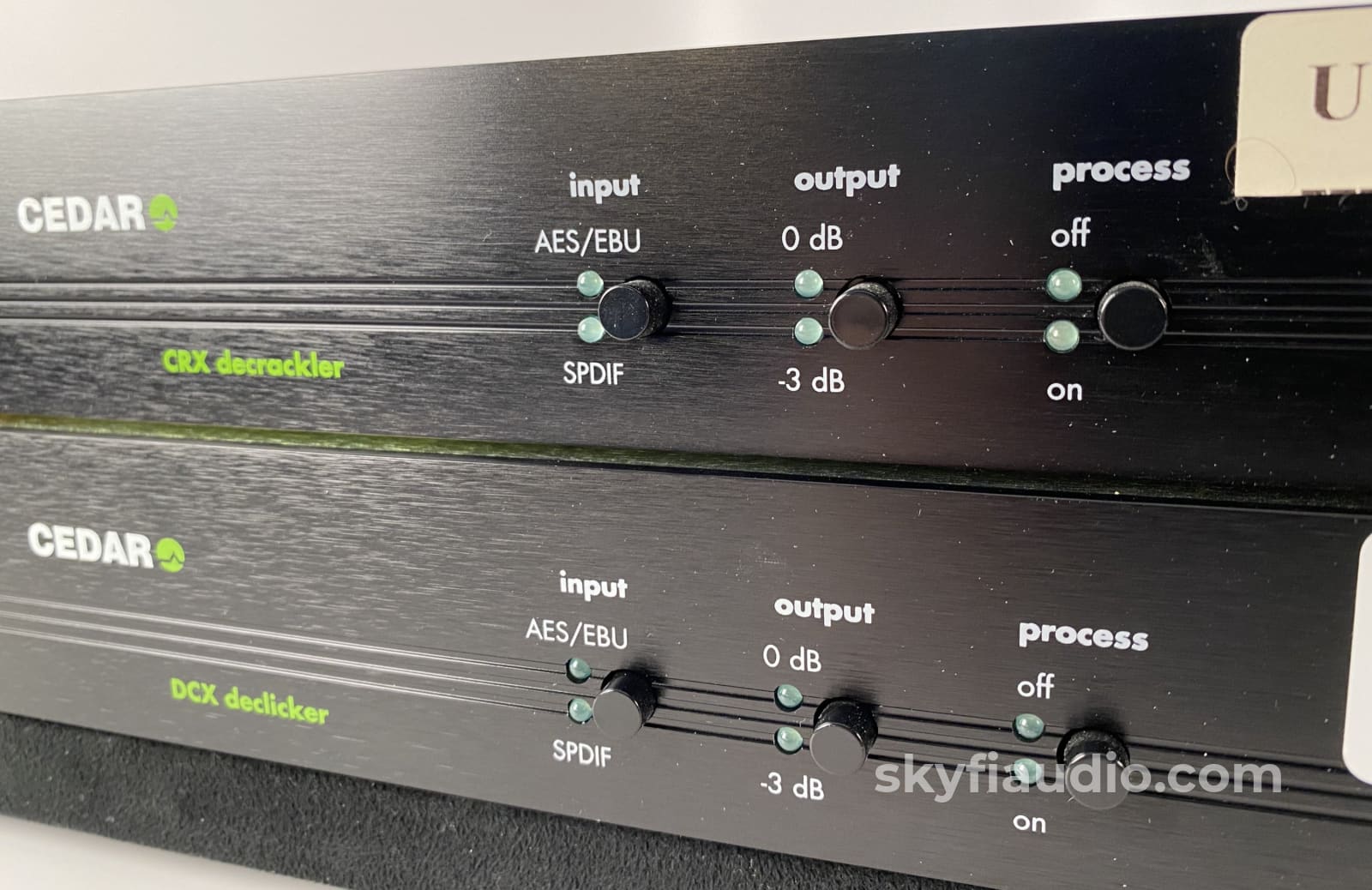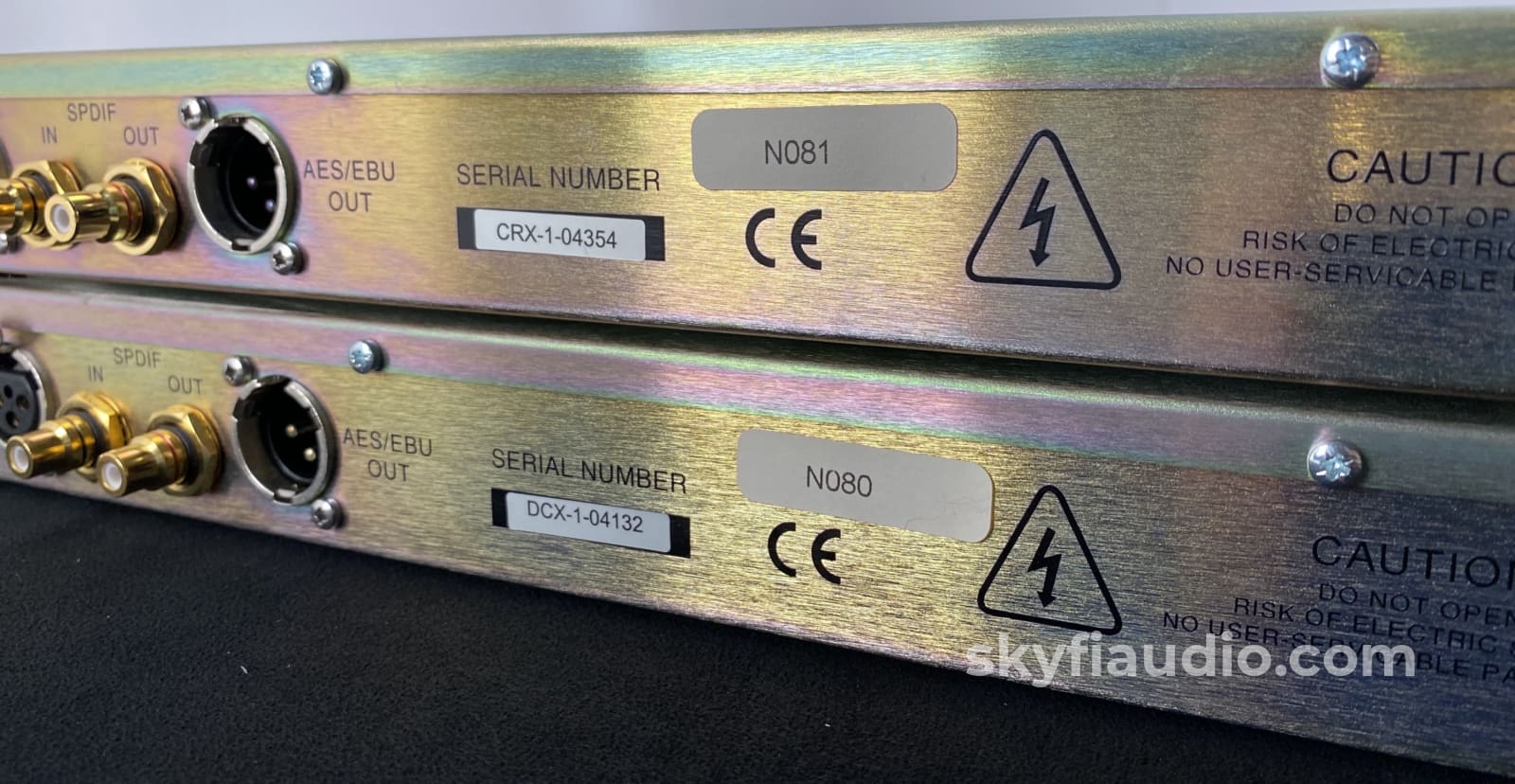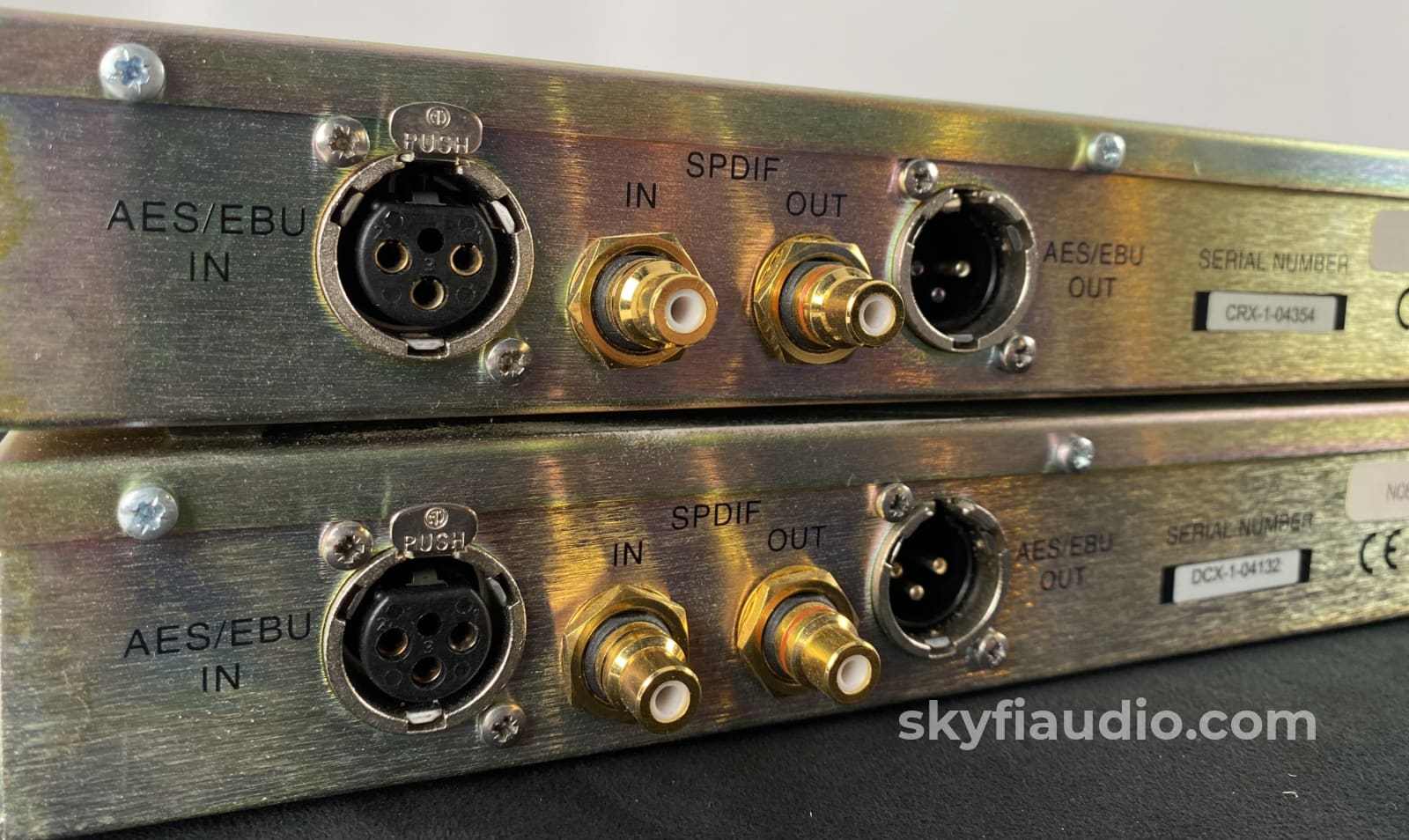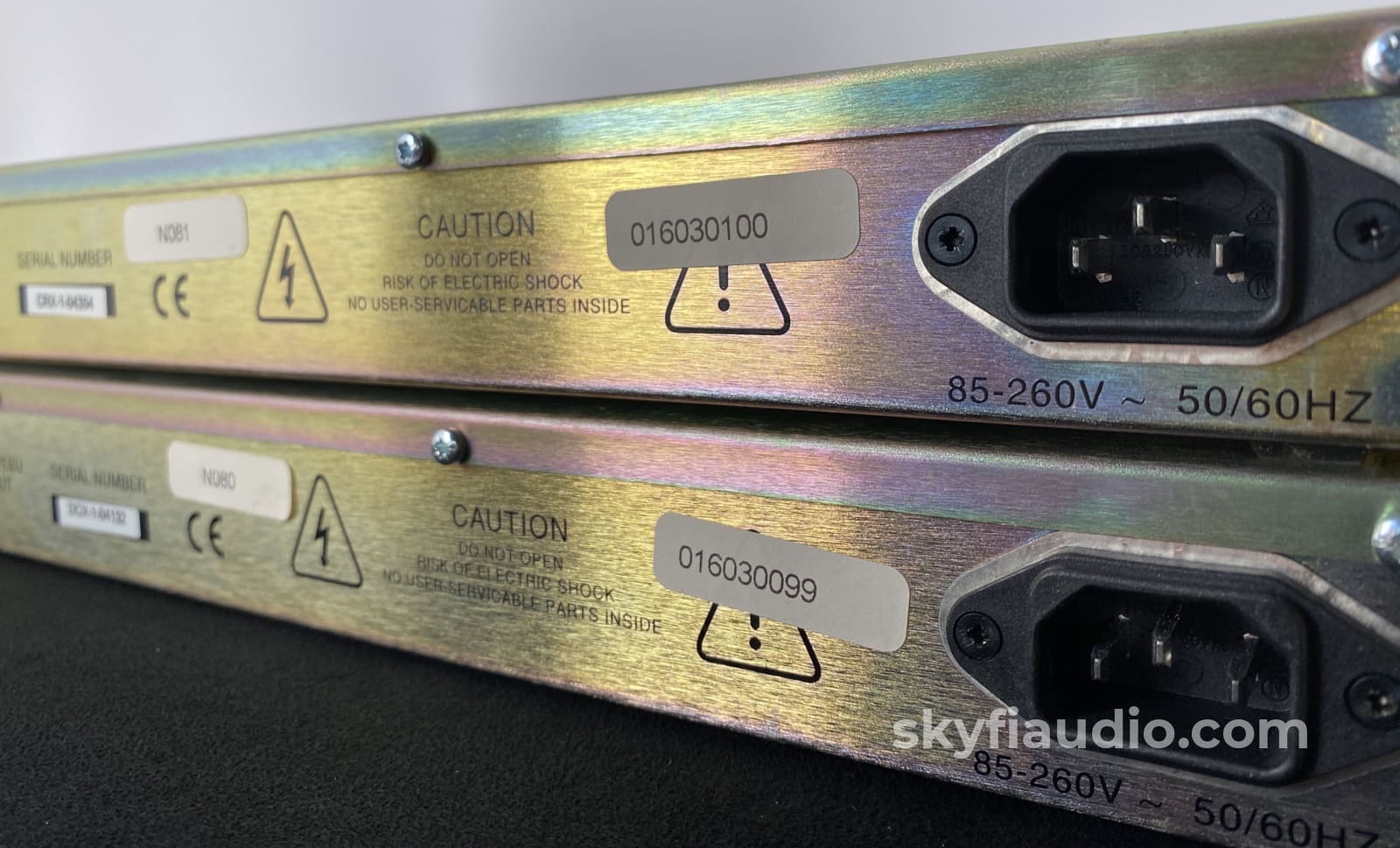








CEDAR Audio DCX Declicker and CRX Decrackler
Free Shipping on *ALL* Electronics (Excluding Speakers, Contiguous 48 US States Only)
Pickup currently unavailable at SkyFi 479

CEDAR Audio DCX Declicker and CRX Decrackler
SkyFi 479
479 South Broad Street
Glen Rock NJ 07452
United States
Extremely difficult to find these days!
In perfect cosmetic and working condition.
More from CEDAR Audio:
The X Series consists of the DCX Declicker ($5,995), the CRX Decrackler ($6,495) and the DHX Dehisser ($6,895). All are single-rackspace units and can be used separately or may be daisy-chained.
Each unit incorporates a 40-bit, 50MFlops floating-point processor, and, unlike other CE-DAR hardware, all of the X Series units operate in the digital domain only (no internal A/D or D/A converters). All three are equipped with both S/PDIF (coaxial) and AES/EBU digital I/O, and provide 24-bit I/O resolution at any sample rate from 30 to 50 kHz.
The obvious advantage of eliminating A/D and D/A circuitry is reduced cost, but it also reflects a reality of the audio restoration marketplace: More often than not, material to be worked on is first archived to some digital media before restoration begins. This is especially true in cases of deteriorating tapes, discs or cylinders where there may only be one or two plays left on the original media. Obviously, extra converters become a redundant ex- pense when two units are daisy-chained, which is a typical setup. Users who need A/D and D/A converters may pick and choose from the vast selection of third-party converters on the market or simply rely on existing converters in their DATs, consoles or other signal processing. To further reduce cost without compromising quality, the X Series products have no provision for MIDI, SMPTE or RS-422 control; my guess is that most users don’t need these anyway.
SIMPLE OPERATION
The DCX Declicker removes up to 2,500 clicks/scratches per second. A signal modeling algorithm analyzes the input signal over several milliseconds and uses that information to replace each click with an interpolation based on that resonant model. Operation is simple: Apply an input signal and then adjust the unit’s sensitivity control to determine the amplitude of the clicks to be removed. Too much DCX processing can distort the signal, but the unit’s simple interface makes it easy to establish the optimum processing level.
The CRX Decrackler removes artifacts such as vinyl/shellac surface noise and high-density, small-amplitude noise such as mild distortion and buzz. The CRX takes the input signal and splits it into two components: One is essentially a clean, desirable signal, while the other half has both the degraded signal and the residual part of the clean signal. Once an interpolator circuit removes the noise from the second half, the two parts are recombined, free of the crackle. Designed to be used after the DCX Declicker, the CRX uses a two-knob interface that is fast and intuitive.
X Series processing happens almost instantaneously, in near-real time. In the case of the DCX and CRX, the delay is slightly over a frame (38-49 ms); the DHX typically has a processing delay around 180 ms-still less than 11/45 of a second. The X Series units do not have any ability to store presets or parameters (back to that minimum price/maximum power philosophy) but non-programmability is hardly an issue with the X Series’ minimal-knob interface.
SURFACE NOISE PROBLEMS
I began by testing the X Series with some difficult material-a number of fairly trashed pre-1925 acoustic 78s with ample surface noise problems. One of the discs also exhibited damage along its outer grooves on one edge, a result of fungus once having digested the vegetable material in the disc itself. After cleaning the discs, I played them back through an Esoteric Audio Ramses 78 player (using its 71.29, 76.59, 78.26 and 80 rpm pitch-correction presets) routed through a custom phono preamp (essentially a stock outboard phono preamp but equipped with a switch for bypassing the RIAA equalization circuit), and I stored the recordings on a 20-bit Alesis M20 deck with the AES/EBU I/O option.
Because of their condition, these tracks were a challenge, to say the least. Tape hiss wasn’t a problem here, though, so the DHX wasn’t needed on this project. I just daisy-chained the DCX and CRX to the M20 and monitored through a Stax D/A converter and Meyer HD-1 speakers.
In less than a minute, I had the controls adjusted for optimum quality. The effect was dramatic. It didn’t exactly sound like a pristine 24-bit/96kHz recording, but it sparkled and jumped back to life, with more than 85% of the noise artifacts removed. Any remaining deficiencies could have been touched up with some gentle mastering EQ and/or some wave-tweaking on a workstation system-however, the CEDAR units were working in (near) real time (certainly much faster than loading tracks into a DAW), and it was gratifying to hear the results almost immediately.
On the next track, where the original disc was in better condition, the effects of over-processing were apparent. However, once I’d backed off the controls a bit, the results were equally amazing. The lesson here is that the X Series processing is not a “set and forget” procedure-for best results, each recording has to be tweaked individually. On one disc where most of the grooves were nearly gone, no amount of processing could save it.
I then transferred some mid-’70s LPs. Their condition wasn’t bad, but they had been pressed on inferior vinyl and had many clicks and pops. Here, the difference between the original disc and the CEDAR version was night and day-the DCX Declicker really shined, removing nearly 100% of the pops without leaving any audible artifacts.
Next up, I used the DHX Dehisser to restore the sound from a vintage (early ’70s) 11/42-inch black-and-white reel-to-reel videotape. The tape hiss was hideous, which made it nearly impossible to pull up the dialog, especially in sections where the levels were low. I had previously nearly given up on this project, as conventional methods-gating, EQ and my vintage Burwen noise-reduction unit-couldn’t handle the job. But the DHX removed nearly all of the hiss and made the track more intelligible without destroying the character of the original track or dulling the sound.
On music tracks played from an analog cassette, the results were equally impressive, though in this case the original recording was of higher quality. The DHX maintained a constant phase relationship between the tracks and kept the soundstage intact. Nice!
CEDAR’s X Series provides a remarkable set of tools for audio restoration in a compact package that is easy to use and flexible enough to handle a variety of audio problems. Retailing from $5,995 to $6,895, these are not inexpensive, but at less than half the cost of its predecessors, the X Series makes CEDAR-quality processing available to a wider market of audio producers and facilities.
Please click here for detailed specifics regarding our specialized packing process that separates us from the rest.
|
Item |
Included |
|
Original Box |
No |
|
Manual |
No |
|
Remote |
Not Applicable |
|
Cables |
Yes - Power |
|
Physical Condition |
8 |
|
Working Condition |
10 |
Choose options









